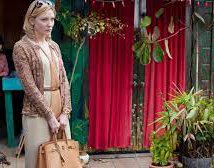As rising inflation and interest rates dent disposable income, Charlie Porter re-evaluates his habit of buying high-end fashion, writes the @FinancialTimes. It is the reflection of an impoverished fashion enthusiast during this period of "deep economic crisis" who begins to think positively about the value of old shoes and old clothes. It's about extending their life cycle and ensuring that things that can be reused don't end up in landfills. [It's time to rethink our approach to luxury fashion – FT]
In September 1982, The Face magazine ran a cover story titled “Hard Times”. Written by Robert Elms, currently a radio presenter at BBC London. Elms pinpointed a tough, thrifty look that appeared in London’s clubs: old ripped Levi’s 501 jeans, tough leather shoes, check shirts that have been “torn to shreds”. It was the third year of Thatcherism in Britain. Elms wrote that “everyone who can feel now is in pain”.
Forty years later, I am writing this piece at home in a scarf and sweater, not wanting to turn on the heating, in an effort to save energy bills. There is an economic parallel: 1982 was the last time UK inflation was above 9 per cent. Back then I was a child without responsibility, looking for fashion as a means of self-expression. Today I have a family and a mortgage.
Fashion is psychological. Shopping is often framed as a treat for ourselves. But even for those with above average salary, disposable income is disappearing. Funds that used to go on a fashion splurge can now be swallowed up by higher mortgage payments, gas bills and rising grocery costs. In this period of “profound economic crisis”, to borrow a phrase from the recent prime minister, it may be helpful to introduce ourselves to a new pattern of thinking about what we buy, when.
Instead of buying things that look used, maybe we should wear what we have ourselves
For this, we need a new strategy. I have often bought from luxury fashion brands, but most of the time I enjoy them like an armchair football supporter. The quarterly result of LVMH and Kering is a football score; show reviews is my match report; scouring ecommerce sites is like playing FIFA 23; see what stocks are left unsold at the end of the season with relegation zone drama. I can get pleasure from luxury fashion without buying anything from luxury fashion.
This weekend is my twice-a-year change of clothes, postponed this year due to staying warm for so long. Earlier, the change was swift, swapping T-shirts and shorts for thermals and fleeces. This season, I took my time and went through everything. I want to build a new wardrobe from what I already have.
There is a fine merino navy cardigan I forgot about, bought last year from the Sunspel factory shop in Long Eaton; a thick black cashmere sweater from The Elder Statesman, deliberately wrapped and so messy, also blew my mind.
I took it all out, so I’m now reacquainted with my everyday work clothes, too thick to wear during this summer’s heat wave. Some were bought new, from places such as Buruh and Antosan; A few years ago I bought secondhand hickory-striped smocks from Here After on London’s Brick Lane.
Some old luxury purchases have come back into circulation. I bought an olive green utilitarian shirt jacket from Saint Laurent when Hedi Slimane was in his hem, which I haven’t worn in years. I’ve been wearing it pretty much every day since summer finally relented. I still wear jeans from Slimane’s first season at Saint Laurent a decade ago, and I love wearing them this year more than ever.
We can also find inspiration from the apparently wealthy. This is a tradition in the English aristocracy that is titled but broken. This is the age-old way of presenting to the world based on frugality: the battered old tweed jacket that has passed generations; knitted used; a Barbour dragged out for one more season. Frugality Posh is a style often aped by fashion, but usually about looks rather than sensibility. Instead of buying things that look used, maybe we should wear what we have ourselves.
Frugality can also lead to a more serious commitment to sustainability. Fashion has been stubborn in its resistance to more mindful practices, no matter how much lip service is paid to environmental concerns. If consumers change their behavior to buy less, and buy better, we consume less. If we get to that point by liking our own actions, sustainable behavior is more likely to be long-term.
The truly frugal will always take advantage of a canny purchase. One of the most praised looks at the latest spring/summer 23 show was worn by Kate Moss at Bottega Veneta. It looked as if he was dressed in a thrift store plaid shirt, a white shirt and blue jeans, but it was all printed leather. If you go to the store next spring, buying the whole outfit will cost thousands. To see it now, it’s easy. It’s the same style as “Hard Times” forty years ago. Just go to a thrift store and buy a plaid shirt, a white shirt and some nice faded blue jeans.



